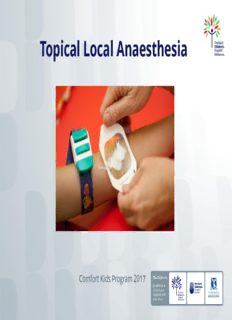
Topical Local Anaesthesia PDF
Preview Topical Local Anaesthesia
Topical Local Anaesthesia Comfort Kids Program 2017 Topical Local Anaesthesia (LA) • How does topical LA cream works • Misconceptions • Cautions • Preparation • Application • Alternatives • Dosage • Documentation Basic Principles Topical anaesthesia – is a drug mixture(s) that provide a local anaesthetic effect Topical anaesthesia effects the dermal pain receptors and nerve endings in the epidermis and dermis layers of the skin. Only the area in which the drug is applied will become “ numb” at a depth of 3-4 mm Children and adults report feeling: •pressure e.g. when the cannula is inserted •movement e.g. vein rolls •sensations e.g. tapping or palpating the skin •warmth or itchiness (where drug applied) 2009 WebMD, LLC. Amethocaine 4% = AnGel • Amethocaine is an ester type local anaesthetic. • It has high lipid solubility and high affinity for neural tissue. • A high protein binding capacity (76%) maintains the drug at the receptor site with formation of a long-lasting depot in the stratum corneum and clearance by esterases in the skin and bloodstream. • It inhibits the initiation and transmission of nerve impulses by stabilising the neuronal membrane (by blocking sodium ion influx across the axon). Neuronal conduction is first blocked in the autonomic, then in sensory and finally in motor nerve fibres. Lignocaine 2.5% / Prilocaine 2.5% Emla • Lidocaine and prilocaine are amide-type local anaesthetic agents • EMLA Cream provides dermal analgesia by the release of lidocaine and prilocaine from the cream into the epidermal and dermal layers of the skin and by the accumulation of lignocaine and prilocaine in the vicinity of dermal pain receptors and nerve endings • Both lidocaine and prilocaine stabilize neuronal membranes by inhibiting the ionic fluxes required for the initiation and conduction of impulses, thereby effecting local anaesthetic action. Misconceptions • Topical medication can completely numb all of the nerves • Nerves located in the mid to deeper layers of the skin are not effected by topical anaesthetic drugs • The child won’t feel anything or its pain free is misleading • Shorter application times are equally effective • Research shows ≤ 30-45 min is not enough time for blood sampling or injections • Depends on agent & procedure Misconceptions • Emla cream causes vasoconstriction • Vasoconstriction may occur but it also can be caused by illness, dehydration & anxiety • AnGel causes a rash this is an allergic response • Mild transient erythema (redness) & itching due to the vasodilatory effect & may persist for hours Caution • Family & Patient keep away • eyes causes irritation • the mouth to prevent ingestion • Health care professionals • apply with gloves • prevent accidental absorption or contact with eyes Why is topical LA not used? • Perceived short duration of procedure • Perceived insignificance of pain/procedure • Perceived alteration to vascular accessibility • Time required for cream to work Preparation – Child & Parent • Age specific explanation - EPT • Describe the type of drug • For all patients use the name “AnGel” or “Emla” cream • For parent & teenagers more information is OK • Explain local anaesthetic drug • Consider what you would you tell a child How it will look & feel ?
Description: